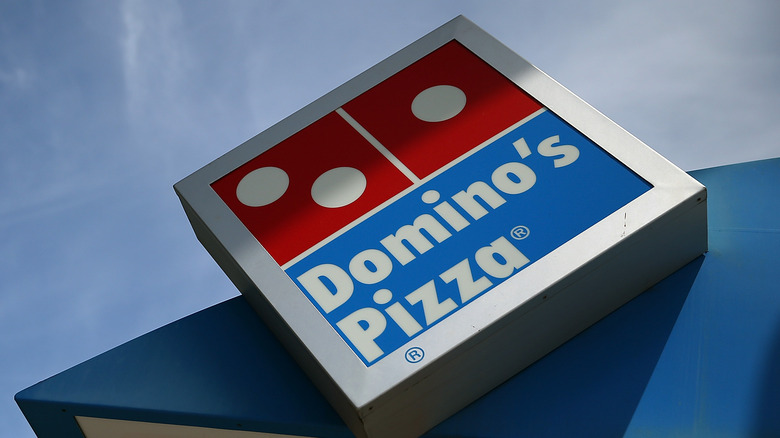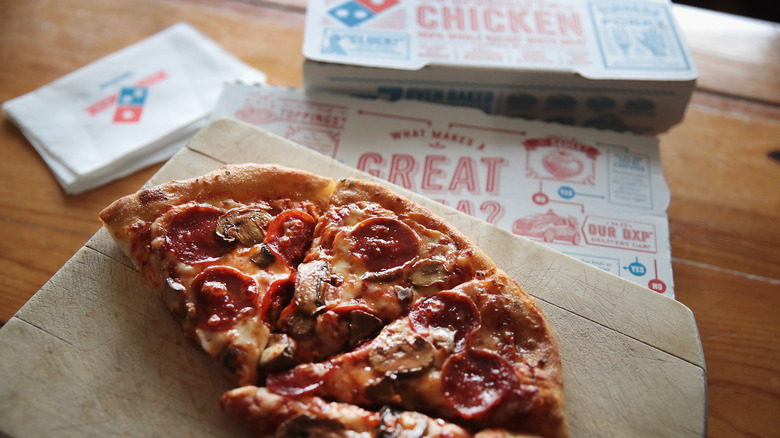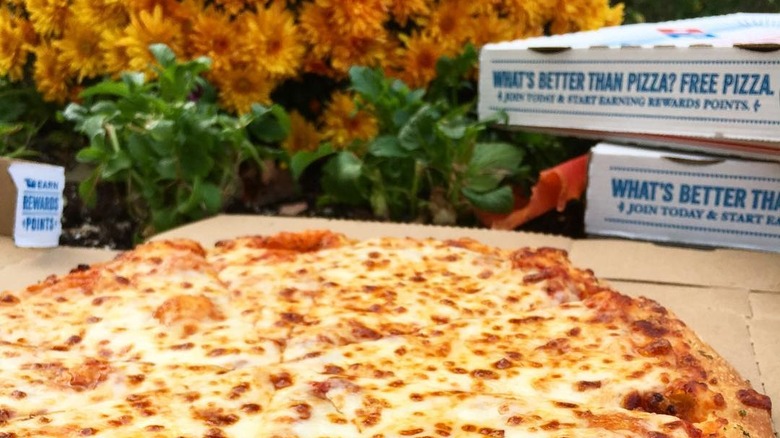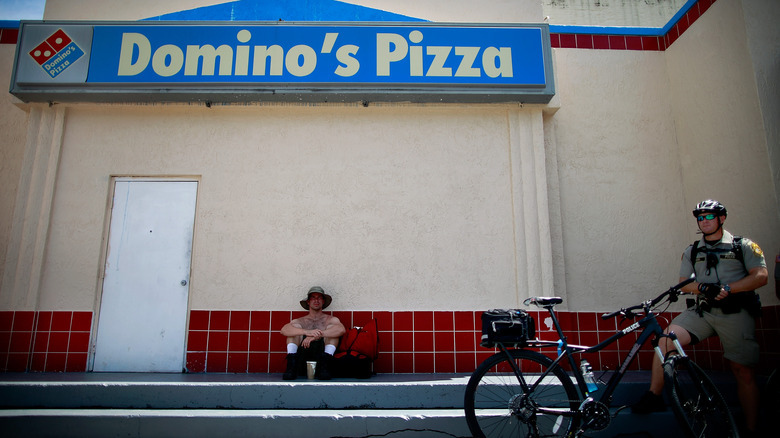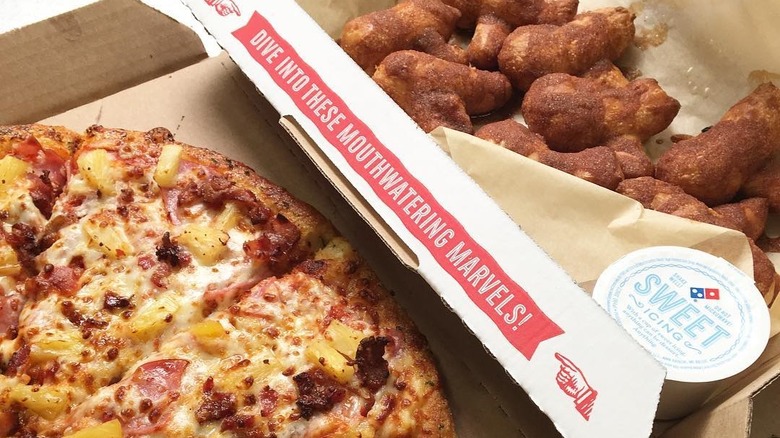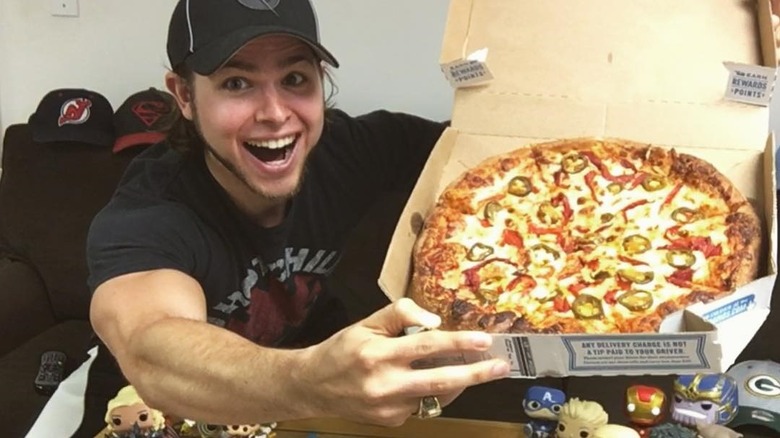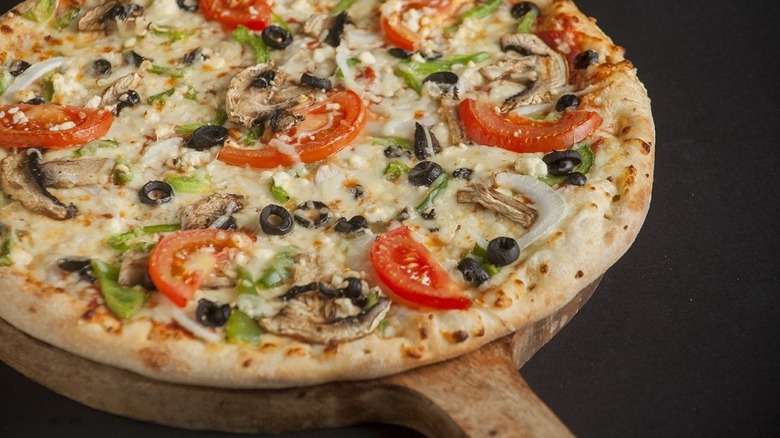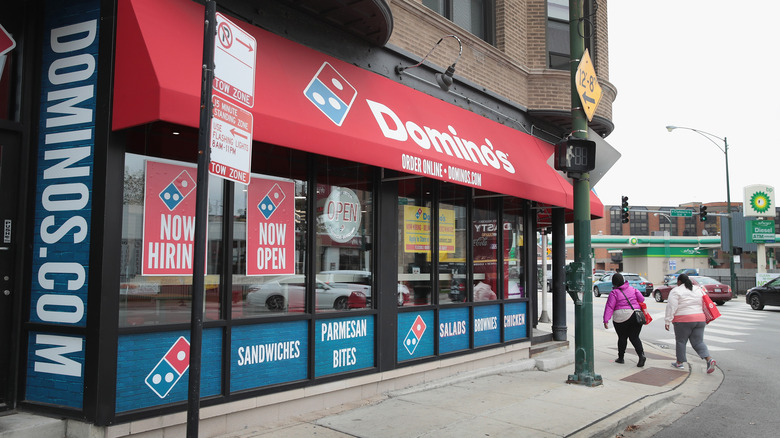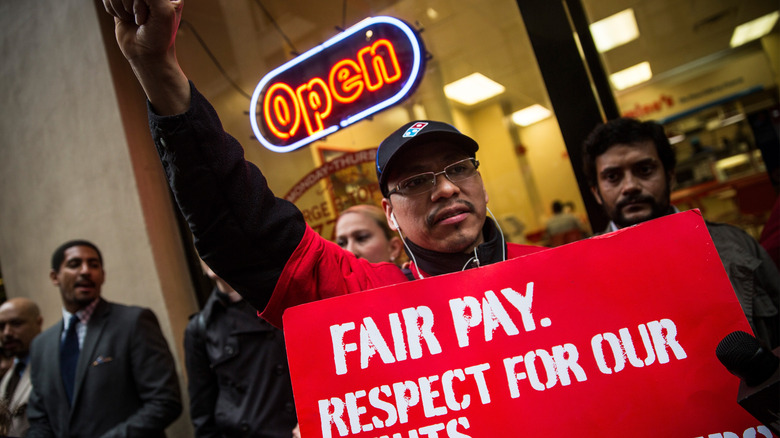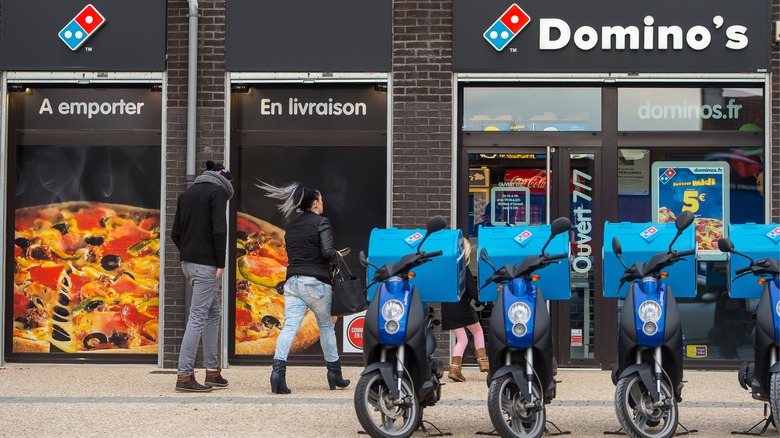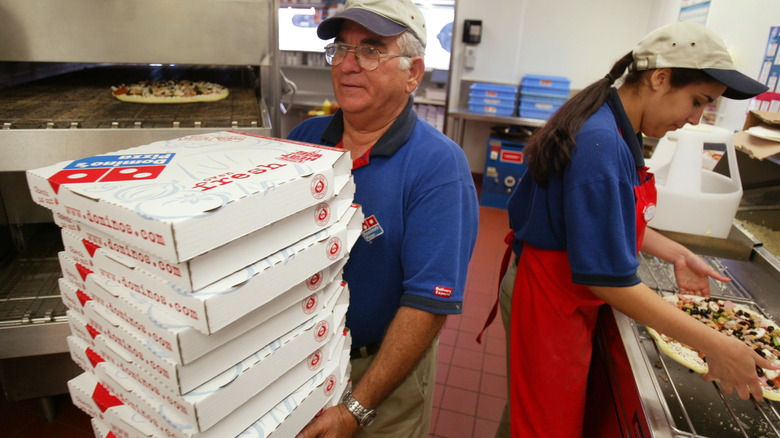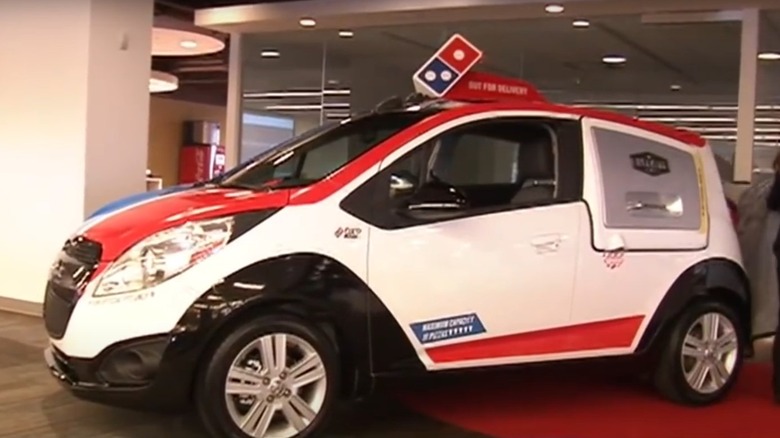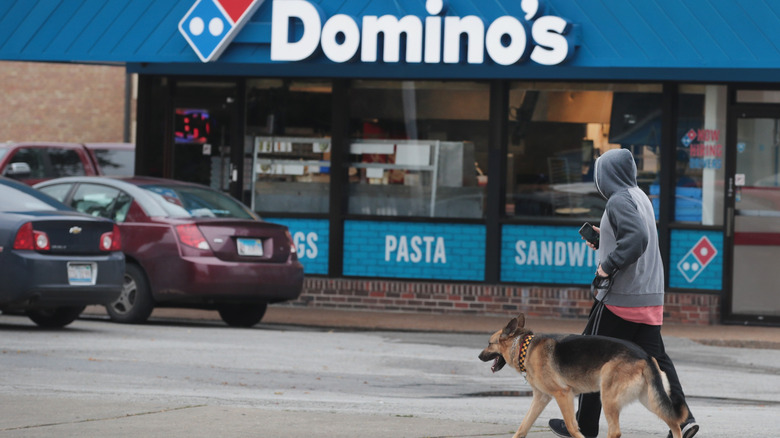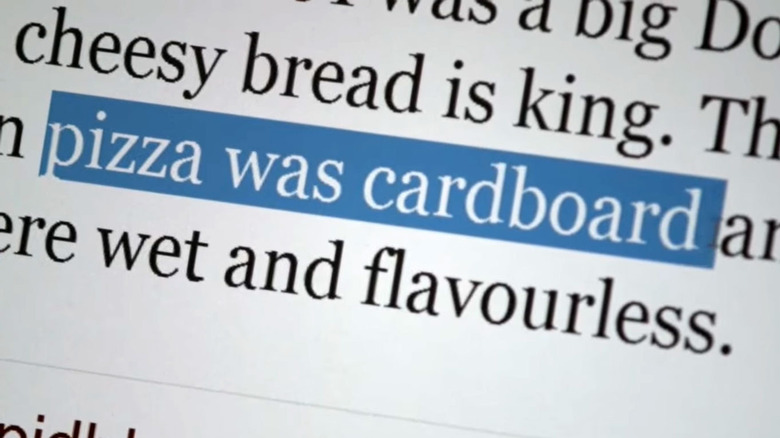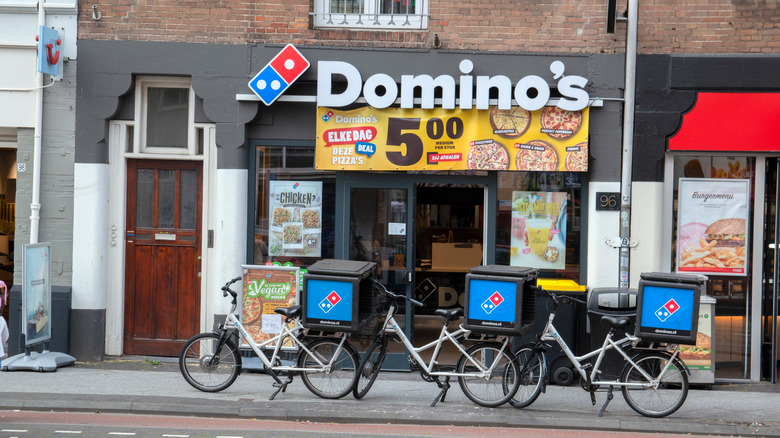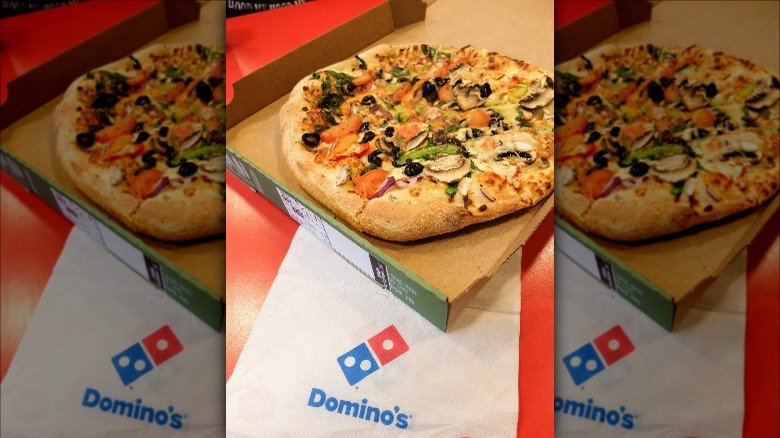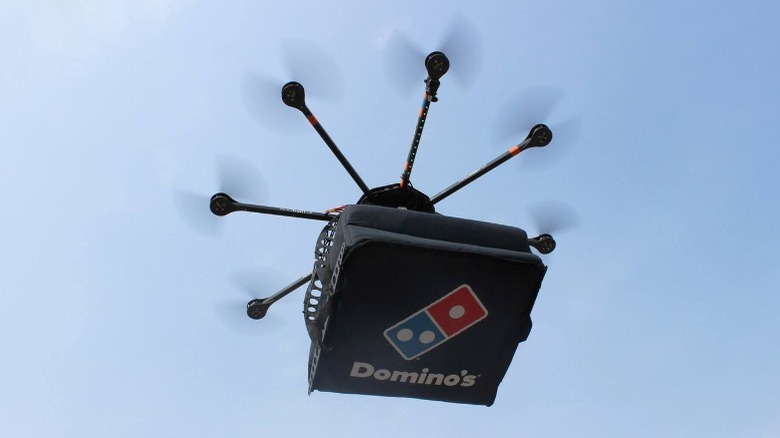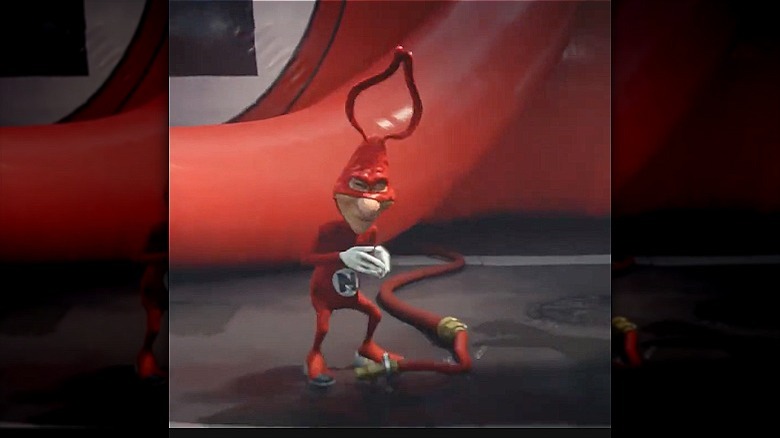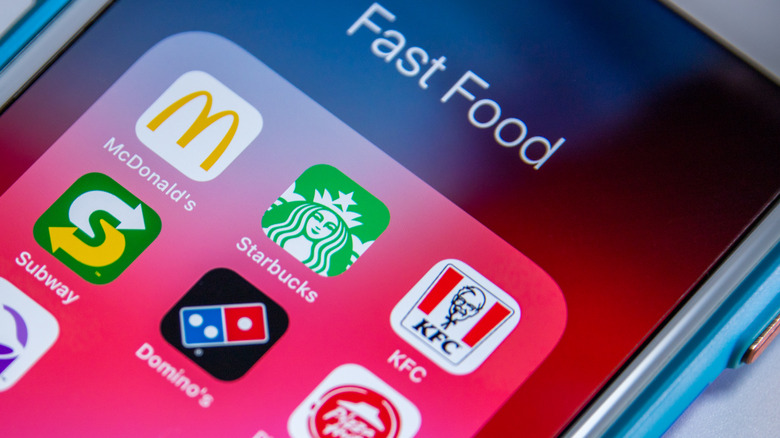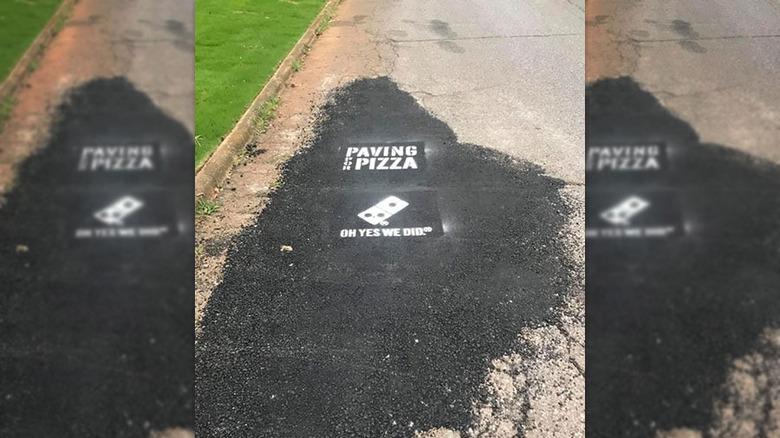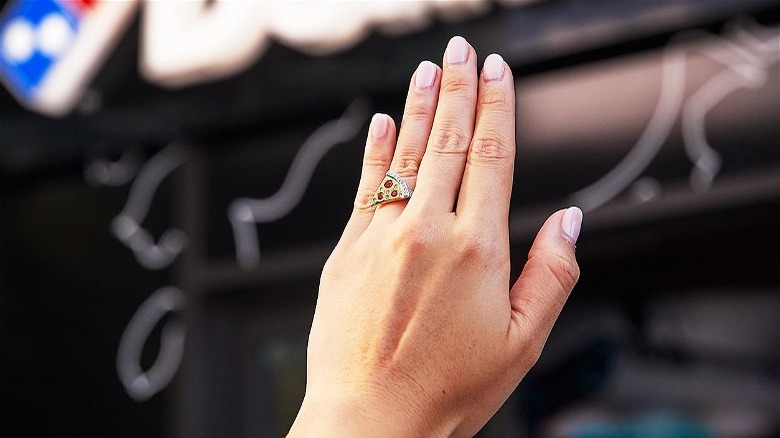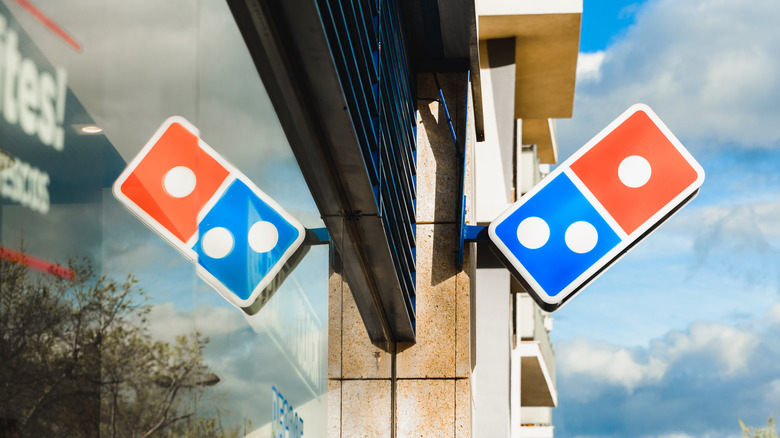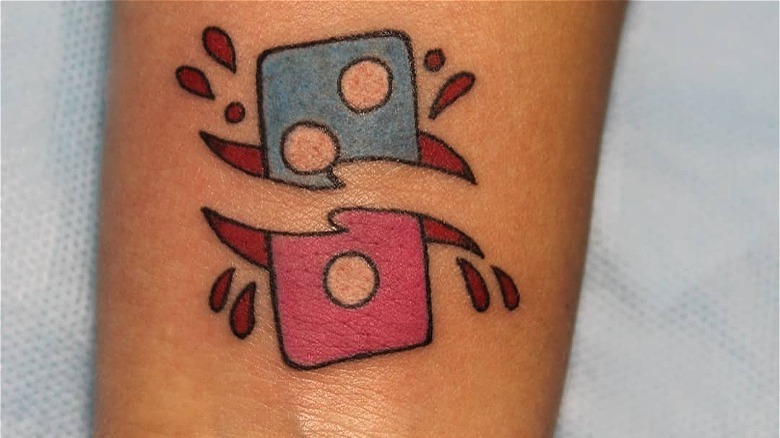The Untold Truth Of Domino's
It doesn't matter if you love them or hate them, you've had their pizza. It's delivered to office parties and college campuses in giant piles, it's a staple of football games, it fills the hole, and satisfies that pizza craving. You've ordered from them... but how much do you really know about them? Not all you should. Let's fix that.
Domino's founder was almost a priest
Tom Monaghan's father passed away when he was only 4 years old, and he was 6 when his mother had no choice but to turn him and his younger brother, James, over to the care of a Felician Sisters orphanage. According to The Balance, she got on her feet and was later able to take the boys back into her care, but Monaghan had already developed firm religious beliefs — thanks to a nun named Sister Berarda, he told The New Yorker — so strong, he briefly considered going into the seminary and becoming a priest. Instead, he ended up serving three years with the Marines, then returning to his hometown of Ann Arbor, Michigan. He had goals of being an architect, and alongside an enrollment in the University of Michigan he and his brother bought a pizzeria.
Originally named DomiNick's (after previous owners Dominic and Nick), they changed it to Domino's Pizza. When they opened the fourth store, Monaghan bought his brother's share in the business. The price? A Volkswagen Beetle.
Domino's invented the pizza box as we know it today
Monaghan's pizzerias failed at first, but he shaped the business to cater to the college students in town. He dropped everything but pizza from the menu (via The Balance), established his delivery service, then revolutionized it with something we take for granted today. Monaghan made pizza boxes that were extra-durable and insulated. That meant he could deliver an entire stack of pizzas to a group of college kids without the stack collapsing and making a saucy, cheesy mess, and it also meant those pizzas were still going to be hot when they got there. It was a winning combination that directly led to his 30-minute guarantee roll-out in 1973, and within 10 years he was rich enough to buy the Detroit Tigers.
The founder walked away to go on a moral crusade
By 1985, Monaghan sat at the top of an empire that included 2,800 locations and a personal fortune that allowed him to invest in things like the Tigers, a 200-strong collection of classic cars, and an island resort. When Bloomberg looked at the empire in 2017, they also looked at the Monaghan's sale of the company. In 1998, he sold 93 percent — for $1 billion — to Bain Capital LP, which was run by Mitt Romney at the time.
According to The New Yorker's 2007 interview with the eccentric billionaire, he really wanted to help guide people on the path to Heaven, and do what he could to rescue his beloved Catholic Church from what he saw as a downward spiral. When he learned about the different beliefs developing within the church he had found his personal crusade, and he started with getting involved with supporting the Nicaraguan Contras and ultimately funding a $4.5-million cathedral. In 1989, he stepped down from being Domino's president and CEO, swore what he called "a millionaire's vow of poverty," and started selling off his property. When he sold the company in 1998, it was with the declaration: "I want to die broke."
It has an unconventional sort of headquarters
Domino's has their headquarters at a sprawling, 270-acre complex in Ann Arbor, Michigan. According to Bloomberg, around 800 people work in the three Frank Lloyd Wright-inspired buildings that each stretch for about half a mile through a prairie-pastoral swath of land. Also sharing the land? A herd of free-roaming buffalo and the animals of The Petting Farm at Domino's Farms.
It might not be as idyllic as it seems, though, and when a reporter for The Independent headed there in 1998 to talk about Domino's big sale, he got the cold shoulder. David Usborne called ahead from the airport and was told to leave, but didn't. When he asked for a press packet regarding Domino's sale, the brand reluctantly agreed. He was met at headquarters by Monaghan's daughter, Maggie — the same person who told him to go home — and a security guard who told him no one wanted him "snooping around." His visit only lasted minutes, but he did walk away with one observation: women were restricted to a dresses-and-skirts only dress code.
Domino's didn't want to publish nutritional information
Domino's lack of transparency extended to their pizza, too. In 2012, it led the fight against new government regulations that would require restaurants to list their nutritional information. The Bangor Daily News says Domino's wasn't the only pizza place protesting the requirement — it was joined by Papa John's, Pizza Hut, and Little Caesars — but Domino's did lead the charge. It was based on the idea it just wasn't feasible, and the sheer number of possible combinations of ingredients a customer could order on their pizza meant there was no way it could assemble a reliable, accurate calorie count.
The fight went on for years, according to Business Insider, and Domino's was the loudest voice. By 2015, the FDA was only requiring pizza places to list calorie ranges for each possible ingredient that could be ordered, but Domino's VP of communications Lynn Liddle responded with, "What I don't want to do is put ranges that consumers will not understand and make my small business pay for it."
One man ate Domino's every day to prove a point
We all know it's not good to eat a whole pizza every day, in spite of Domino's Pizza Planner that shows customers just how to responsibly enjoy a few slices of Domino's. One absolute legend decided he wasn't going to be told what to do, and chose Domino's to prove a point about eating healthy and working out. Brian Northrup ate a whole Domino's pizza every day for 367 days (in addition to other foods). By the end, he had lost 5.9 pounds, proving the point he'd set out to make. You don't need to stress about everything you eat, you don't need to feel like you've failed a diet because of a few pieces of pizza, and you can absolutely exercise away a bad diet... even though he clarified to Food Beast that he didn't recommend it. Thanks, Brian, and thanks, Domino's!
Domino's international stores have some wild stuff on the menu
If you stop by any one of Domino's international locations for a quick bite thinking you're going to get a taste of home, you'd be sorely mistaken. Domino's menus outside of the U.S. look extraordinarily different, and it catersto regional tastes.
Head to Japan, says Adage, and you'll get things like snow crab, beef stew, shrimp gratin, and Mangalitsa pork with Bordeaux sauce. If you'd care to spend around $50, you can even get a Domino's pizza topped with the highly controversial foie gras.
What else will you find? Domino's Ireland says their most popular topping is the familiar pepperoni, but the restaurant chain also offers customers grilled lamb in the Netherlands, lamb and pickled ginger in India, black bean sauce in Guatemala, squid and shrimp in Taiwan, potatoes in Korea, and capsicum in Australia, because of course you can, it's Australia!
Proceeds founded a Catholic university and town
As a part of Monaghan's plan to set people on the path to Heaven, and "die broke," The New Yorker says he took $250 million from the sale of Domino's and put it into what he called the Ave Maria Foundation. He started out funding elementary schools, but his vision grew into establishing a community and university that would operate under the guidelines of the Catholic faith. Originally destined for Ann Arbor, Monaghan's college met with some serious local pushback, and he ended up partnering with a Florida development company who agreed to give him the land for his university if they could develop the community around it. The college became Ave Maria University, and the town is Ave Maria Town.
There's been a huge number of problems, including the controversy over Monaghan's plan to restrict things like contraceptives and what kind of entertainment is available to his town's residents. He'd also opened his law school in Ann Arbor and made the decision to move to Florida without consulting his students or professors, who weren't keen on the idea of packing up and moving. According to Business Insider, growth has been slow, and in spite of Monaghan's insistence the town was welcoming of all faiths, there are though only Catholic buildings and imagery.
In 2021, it was ranked one of the "Top 25 Selling Master-Planned Communities" in the United States and the highest-ranking community in Southwest Florida (via Naples Daily News). Despite its controversial beginnings, Ave Maria has grown into a flourishing town with a university, law school, award-winning country clubs, and surprisingly no Domino's.
Domino's hasn't taken a stance on abortion, but the founder has
One of the first — and most important — rules of business is not to alienate potential customers. Domino's — and Monaghan — didn't get the memo, and in 2013 the restaurant brand caused a massive stir when he headed to court in order to go head-to-head with some of the regulations put in place by the Obama administration. According to Life News, Monaghan's stance was that it was "gravely immoral" to require deeply religious business owners to pay for their employees' birth control drugs or drugs that had the potential to cause abortions. He complained it was a violation of his rights, and it's important to note he was arguing on behalf of Domino's Farms, not Domino's Pizza.
It's a distinction not many people could be bothered to make, and Snopes says the relationship between Domino's and Monaghan's controversial beliefs is a complicated one. Domino's official statement is that it has no official stance, and it doesn't support groups on either side of the abortion debate — it's just good business. But, Snopes also says Domino's sales filled Monaghan's pockets, and then ended up in the coffers of pro-life groups. So, there's that.
It's been accused of some serious wage theft
In 2016, Domino's got hit with a major lawsuit that, according to The Nation, has the potential to revolutionize the workplace for people across the country. The suit was brought by the New York Attorney General's office on behalf of Domino's employees, and it claimed both Domino's corporate and franchise owners hadn't been following the letter of the law when it came to giving out fair tips and overtime pay. It was no accident, either, as the results of a multi-year investigation found the software Domino's uses to keep track of payroll — called PULSE — had been programmed to short employees on their pay.
There were other problems, too, and the suit stated the software allowed corporate to micromanage what went on in franchised locations. The software even issued notices to managers if it was time to discipline or fire an employee, and that sort of management means everyone is liable in the wage theft accusations. It's not just small change, either — 78 percent of stores were ultimately paying less than minimum wage. Domino's defended their practices, but the lawsuit might be one of the catalysts for unionizing food workers.
Domino's dropped its 30-minute delivery guarantee
Domino's 30-minute delivery guarantee is credited with being one of the reasons the business was so successful, but there's no guarantee anymore. What happened?
There are a ton of rumors, including one that a driver hit and killed a child while racing to get a pizza delivered. Snopes says that's not true, at least, not 100 percent. Monaghan announced the end of the 30-minute guarantee in 1993, and the official reason was that he wanted to get rid of "a public perception of reckless driving and irresponsibility."
And while that was the official reason, that perception came from some tragic accidents. In 1989, a 49-year-old woman was hit by a Domino's driver and suffered severe head and spinal injuries (reported The LA Times). And in 1990, a 41-year-old woman was killed in a collision with a Domino's delivery van, a crash that injured her three sons and a friend. So, Domino's never stated death and injury was the reason for dropping their guarantee, and instead said it was due to public perception. Minor details.
There's still been some tragic accidents involving Domino's drivers
Domino's dropped their time guarantee and replaced it with one that relied on quality, but it didn't stop the accidents involving their drivers. In 2013, Forbes reported a Texas family was awarded a $32 million settlement after a delivery driver was involved in an accident that caused the death of a 65-year-old woman and left her husband with permanent brain damage. In 2016, The Orlando Sentinel reported on another Domino's tragedy. Yvonne Wiederhold was awarded $9 million after her husband's death. Richard Wiederhold was involved in a collision with a Domino's driver, a crash that left the district fire chief paralyzed from the chest down with injuries that led to his death 15 months later. Domino's said it intended to appeal the decision, since the driver was an employee of an independent franchise owner.
It created the first purpose-built pizza delivery car
In 2015, Domino's unveiled the results of its latest project, designed to illustrate just how committed to delivery the brand really was. The DXP was a reimagined 2015 Chevrolet Spark, sporting all the gadgets and gizmos needed to make pizza delivery insanely efficient. That included things like a pizza oven that would keep everything at the right temperature, storage compartments for things like soda and dipping sauce, and room for an impressive 80 pizzas.
According to CNet, around 100 DXP delivery vehicles were slated to be delivered within three months of the unveil, and they also added Domino's had reached out to Chevrolet dealers to make sure there were, indeed, dealerships around that could service the cars and the huge amount of special tech they'd been loaded with.
It implemented a program to track you when you're on the way to restaurant
There's no telling where we'd be without the technological advancements that have shaped our world, but even the biggest tech supporters will have to admit Domino's new plans to track their customers is just a little too Big Brother-ish. According to ZDNet, Domino's announced in 2016 it would be adapting the technology it already use to track its drivers' movements to start using it on its Australian customers.
Customers would order a pizza, and if they were heading to the store to pick it up, their GPS would establish a "Cook Zone". When the tracker indicated the customer was in that Cook Zone, Domino's would know it was time to start their pizza so it would be ready — but still piping hot — when they walked in the door. Domino's called it On Time Cooking, and ... creepy, or not creepy?
Domino's built a whole ad campaign around how bad its pizza is
After years of success, Domino's hit a huge stumbling block in 2009. A single YouTube video showing employees doing things to a pizza you don't even want to think about eating was almost the last nail in the coffin of a business with failing popularity. Domino's had a brand crisis on its hands, and whereas most businesses would redouble their efforts to show customers why they were that much better, Inc. says Domino's took an opposite approach. The brand did something risky — it built an entire ad campaign around how bad its pizza was, and then promised to make it better.
And it worked. The response to the campaign where Domino's acknowledged its cardboard pizza was such a success that it did other ads in the same vein, including one where all photos were taken by actual employees, not professionals. That was the idea behind its Instagram, too, says Co. Design, which is filled with slightly stomach-turning pictures of pizza guaranteed to leave you wondering just why you'd order that.
The backhanded campaign could have backfired magnificently, but it endeared Domino's to the new generation of pizza-lovers so much that the chain turned things around.
Domino's is the biggest pizza chain in the world
Domino's hasn't always been the powerhouse that it is now. According to Restaurant Business, Pizza Hut was considered the biggest pizza chain in the world just a decade ago, but began to dwindle due to mounting debt, change in leadership, and declined growth in international markets. During that time, Domino's took into consideration Pizza Hut's weaknesses and now operates in over 18,000 world-wide locations to not only become the largest pizza conglomerate in the world, but also the largest in global system sales. According to Bloomberg Second Measure, 42% of pizza chain sales went to Domino's in 2021 while Pizza Hut accounted for 23% of market share.
However, despite being the largest pizza joint in the world, it still isn't the most popular pizza chain with consumers. According to Statista, Domino's was only the fifth favorite pizza chain for U.S. consumers in 2018 underneath brands like Papa John's and Papa Murphy's. A May 2022 Top Agency report showed that Little Cesar's was the number one preferred pizza restaurant by consumers in 16 states, while Domino's was the preferred pizza chain in only eight states (not conflicting at all).
Domino's hand-tossed and pan pizza are significantly different
One might think that Domino's hand-tossed and pan pizzas were solely the products of effective marketing implemented to highlight minute differences. However, through careful journalistic examination, the two pizzas have wildly different characteristics that could start a turf war (okay, maybe that's an exaggeration) over which pizza is best.
According to the website, the Domino's pan pizza is pressed into the pan (hence the name), while the hand-tossed pizza is stretched and seasoned with the signature garlic-oil blend. The difference is all in the crust explains the food blog, All Pizzaholic, where the Domino's pan pizza has a thick and fluffy crust and the hand-tossed pizza has a thin and crispy crust. That's not the only difference –– when going through the steps to order a pizza, there is a two dollar difference between the hand-tossed and pan pizza, with the pan pizza being more expensive. Despite the surprising differences, both pizzas have at least two things in common –– they're delicious and will induce immense feelings of bliss.
You could get your pizzas delivered by robots one day
It might seem surprising to call Domino's one of the leading innovators for self-driving vehicles and robot delivery, but how else would pizzas and lava cakes get delivered so quickly? In 2016, Domino's was the first company ever to deliver a pizza, specifically a Peri-Peri chicken and cranberry and chicken pizza, via drone in New Zealand (via CNBC). It was so successful that Domino's issued a press release in June 2022 announcing that the production of the SkyDrop delivery drones was complete and ready to be launched in a commercial trial in New Zealand (via PR News Wire). That means it's time to be prepared for pizzas flying and falling out of the sky.
Domino's has dabbled in other cutting edge pizza delivery technology as well. In 2016, Domino's released the first "commercial autonomous delivery" vehicle DOM, previously known as DRU –– Domino's Robotic Unit, in a test trial in New Zealand . According to INSIDER, DOM is essentially an adorable, three-feet tall, motorized mini fridge that can hold up to 10 pizzas and can traverse through grass and busy sidewalks. Then in 2021, Domino's rolled out a self-driving delivery car in the Houston area called Nuro –– the first autonomous delivery vehicle approved by the U.S. Department of Transportation (via CNN Business). Now, the only thing launch next is autonomous pizza ovens.
The Noid, Domino's evil mascot, created a hostage situation
Every fast food superhero needs an antihero to thwart delicious food efforts everywhere. Domino's had its own version of a pizza delivery nemesis –– the Noid –– a red, floppy-eared, bunny humanoid that has worked to get in-between people and their pizza upon his creation in 1986. The Noid had an on-and-off presence in Domino's commercials until 2021 when it was brought back to the big screen to battle against the Nuro robot delivery car.
The controversial mascot created not only cringey commercial moments, but also one of the most intense PR disasters in fast food history. On January 30, 1989, Kenneth Noid held two hostages at gunpoint in a Domino's in Chamblee, Georgia. According to the Boca Raton News, Noid "had an ongoing feud in his mind with the owner of Domino's" and believed he was targeted by "the noids" from the Domino's commercial. No one was injured but Kenneth Noid was soon caught and charged with kidnapping, assault, and theft. Sadly, Noid killed himself several years later after years of mental illness and Domino's abandoned its despised mascot, passing the scapegoat torch to the second worst fast food mascot –– the Arby's oven mitt.
If you or someone you know is struggling with mental health, please contact the Crisis Text Line by texting HOME to 741741, call the National Alliance on Mental Illness helpline at 1-800-950-NAMI (6264), or visit the National Institute of Mental Health website.
Pizza lovers can order Domino's with just a tweet
Domino's leads the pack for technology innovation aside from drone deliveries and self-driving cars. You can order Domino's anywhere, except by telepathy, through your favorite social media sites, smart devices, and even through your home Amazon Alexa or robot. In 2015, Domino's revealed how fans could simply tweet pizza emojis or the hashtag "easy order" to order food in a way that combines people's love for fast food and social media (via PC Mag).
If that seems too technologically savvy and like a good way to get the wrong order, Domino's enabled a feature similar to "Siri" where you could place your order through the adorable delivery robot DOM and it would respond back with a "human-like conversational experience" but with all the food-ordering anxiety (via 2 News). The ordering options are limitless –– you can ping your order through Slack for those mid-meeting munchies, or even place an easy order in fewer steps with the Domino's zero clicks app. If you are feeling nostalgic, call in for a store pick-up, no shame.
Domino's launched a pothole-filling program
According to a generic statistic, countless pizzas are tousled and damaged every year by unsuspecting potholes in the road. Domino's took advantage of the situation and decided to be the change it wanted to see in the world. The company launched the Paving for Pizza program in 2018 in order to fill potholes across communities that customers nominated. It initially received so many nominations (over 137,000!) that Domino's decided to pick a community in each state to reach demand. Domino's leaned into the program for additional marketing and paired it with the company's promise to replace any pizza damaged by potholes (via Restaurant Business).
However, behind every good corporate deed, there are stealthy marketing tactics hidden behind it. In an expose, Vice took a deep dive into the Paving for Pizza program, revealing dozens of email exchanges between Domino's agencies and city administrators. As expected, Domino's doesn't send employees to fill miscellaneous potholes; instead, it offers $5,000 grants to towns for repairs in exchange for documentation of the repaired potholes and the branded "Oh yes we did" stenciled over the filled pothole. Vice elaborated that despite Domino's small good deeds, the real reason behind it was worldwide exposure that would cost less and take less effort than any media-driven commercial ever could.
You can have Domino's wedding and baby registries
Obviously, Domino's is the perfect way to make any happy couple's day all the more magical. Domino's hits all the major possible milestones in someone's life from engagement all the way to having human or fur babies. Domino's 18-karat pizza-shaped engagement ring was revealed in 2020 for the cheesiest proposal possible with ruby pepperoni gems and "diamond cheese" for the one-of-a-kind price of $9,000 (via People).
Of course, you can't forget the perfect and equally cheesy wedding gift. Domino's wedding registry has a gift card option for any stage of the wedding process, from the bachelor and bachelorette party to the post-honeymoon adjustment period. Domino's even has registry options for those postponed COVID-19 weddings, since pizza makes everything, including having your wedding canceled, less painful. There's even a Domino's baby registry powered by Gugu Guru for the soon-to-be exhausted parent(s) too tired to cook or in the mood for a crazy pizza craving –– too bad there isn't a Domino's baby onesie.
Domino's logo has three dots for a special reason
Brand recognition is crucial, and a good logo can make a company instantly recognizable. Domino's is no exception with its red and blue domino with three dots. Simple yet effective, there is a lot of meaning and significance behind Domino's seemingly random logo.
Tom and James Monaghan bought the formerly-named pizza joint, DomiNick's, in 1960 and then changed the name to Domino's in 1965 because it sounded similar enough to stay recognizable among patrons. Naturally, with the name change, the logo was created to become instantly noticeable and associated with the company.
Originally, the logo consisted of a red domino with three dots and a blue domino below it with the company's name inside it (via Inkbot Design). Tom Monaghan told CNN Money that they decided to put " three dots on the domino because (they) had three stores (at the time)." The intent was to add a dot to the logo for every store that was opened but obviously didn't take into consideration how fast Domino's would grow. Eventually, in 2012, the logo was changed to the blue and red domino we all know and remember (via Inkbot Design).
Domino's once had a tattoo promotional deal
People will do anything for free food, or anything for that matter. Remember when Arby's gave away free fast-food-themed American traditional tattoos, such as a bald eagle clutching an Arby's curly fry, for a day in 2018 (via Restaurant Business)? What about California-based chain, Farmer Boys, offering free burgers for a year for customers who got one of three Farmer Boys-themed tattoos?
Well, Domino's is no stranger to the promotional gimmick. In 2018, Domino's launched a promotional campaign in Russia offering 100 pizzas a year for 100 years to whoever tattooed the logo on their body. The promotion was supposed to run for two months but was cut short after four days because too many people got tattoos (via The Moscow Times). The Wall Street Journal suggests that the tattoo promotion was intensely popular because some people needed free food due to Russia's stagnant economy and overall low incomes. The effort wasn't a lost cause though, since the first 350 people who uploaded their tattoos to social media were promised the promotional deal (via The Moscow Times). Those who didn't get the free pizza for life at least got an interesting conversation starter.
